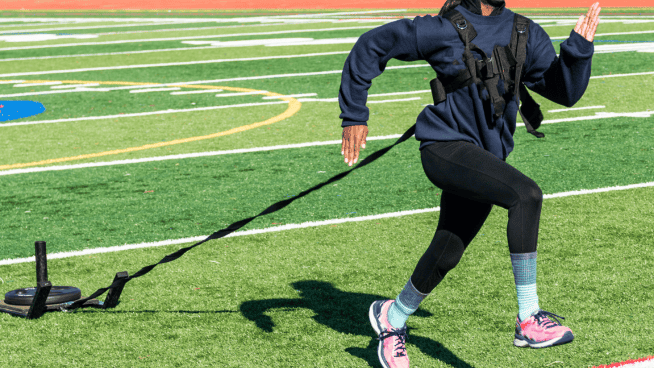Build Explosive Power With Trap Bar Jumps
We are always looking for the big new thing—a secret exercise, a perfect variation, or a forgotten training method. We search for them because we want to optimize our results. Often, this leads us down the wrong path—getting lost in methods and forgetting principles. We miss the forest for the trees.
Barbell Squat Jumps and Trap Bar Jumps are cool power-training methods, but are they supported by accepted principles?
RELATED: Try This Trap Bar Deadlift Variation to Build Single-Leg Strength
Examples of Training Principles
- Want to build muscle? Get most out of your training in the 65-75% intensity range and accumulate lots of volume.
- Want to get stronger? Lift heavy weights (at or above 80% of your max) for moderate volumes.
Want to get more powerful? You’ll need a few things:
1. Increase relative strength
“An individual cannot possess a high level of power without first being relatively strong.” — Cormie et al.
2. Train with loads that maximize power
A study was done comparing groups doing traditional weight training, plyometric training or explosive weight training at loads that maximized mechanical power output. “The experimental group which trained with the load that maximized mechanical power achieved the best overall results in enhancing dynamic athletic performance,” the study reads.
RELATED: 3 Ways to Get Stronger With a Trap Bar
3. Train with exercises that maximize power
Sprint, jump, cut, throw and Olympic lift, because these produce high amounts of power.
Using principles 2 and 3, we can create a method of training that optimizes both the exercises and the load.
Barbell Squat Jumps vs. Trap Bar Jumps
Placing a barbell on your back and jumping is a popular exercise. Picking up a trap bar and jumping is not. These two exercises were compared in a study, using loads of 20 percent, 40 percent, and 60 percent of participants’ 1RM Squat.
Trap Bar Jumps resulted in greater values for jump height, peak force, peak power and peak rate of force development compared to the Barbell Squat Jump. Plus, Trap Bar Jumps beat out unweighted Vertical Jumps when 20 percent 1RM loads were used.
Maybe it’s because the load distribution is better suited for power with the trap bar in the hands than it is with the barbell on the back. This is likely the case, since the Trap Bar Deadlift also produces more power than the traditional straight bar Deadlift.
Grab a light-loaded trap bar and jump with it. It’s an effective method that fits well with the principles for developing explosive power.
RELATED: 7 Trap Bar Exercises You Should Try
References
Cormie, P., McGuigan, M. R., & Newton, R. U. (2011). “Developing maximal neuromuscular power: part 2 – training considerations for improving maximal power production.” Sports Medicine (Auckland, N.Z.), 41(2), 125-46.
Wilson, G. J., Newton, R. U., Murphy, A. J., & Humphries, B. J. (1993). “The optimal training load for the development of dynamic athletic performance.” Medicine and Science in Sports and Exercise, 25(11), 1279-86.
Swinton, P. A., Stewart, A. D., Lloyd, R., Agouris, I., & Keogh, J. W. (2012). “Effect of load positioning on the kinematics and kinetics of weighted vertical jumps.” Journal of Strength and Conditioning Research, 26(4), 906-13.
Swinton, P. A., Stewart, A., Agouris, I., Keough, J. W., Lloyd, R. (2011). “A biomechanical analysis of straight and hexagonal barbell deadlifts using submaximal loads.” Journal of Strength and Conditioning Research, 25(7), 2000-9.
RECOMMENDED FOR YOU
MOST POPULAR
Build Explosive Power With Trap Bar Jumps
We are always looking for the big new thing—a secret exercise, a perfect variation, or a forgotten training method. We search for them because we want to optimize our results. Often, this leads us down the wrong path—getting lost in methods and forgetting principles. We miss the forest for the trees.
Barbell Squat Jumps and Trap Bar Jumps are cool power-training methods, but are they supported by accepted principles?
RELATED: Try This Trap Bar Deadlift Variation to Build Single-Leg Strength
Examples of Training Principles
- Want to build muscle? Get most out of your training in the 65-75% intensity range and accumulate lots of volume.
- Want to get stronger? Lift heavy weights (at or above 80% of your max) for moderate volumes.
Want to get more powerful? You’ll need a few things:
1. Increase relative strength
“An individual cannot possess a high level of power without first being relatively strong.” — Cormie et al.
2. Train with loads that maximize power
A study was done comparing groups doing traditional weight training, plyometric training or explosive weight training at loads that maximized mechanical power output. “The experimental group which trained with the load that maximized mechanical power achieved the best overall results in enhancing dynamic athletic performance,” the study reads.
RELATED: 3 Ways to Get Stronger With a Trap Bar
3. Train with exercises that maximize power
Sprint, jump, cut, throw and Olympic lift, because these produce high amounts of power.
Using principles 2 and 3, we can create a method of training that optimizes both the exercises and the load.
Barbell Squat Jumps vs. Trap Bar Jumps
Placing a barbell on your back and jumping is a popular exercise. Picking up a trap bar and jumping is not. These two exercises were compared in a study, using loads of 20 percent, 40 percent, and 60 percent of participants’ 1RM Squat.
Trap Bar Jumps resulted in greater values for jump height, peak force, peak power and peak rate of force development compared to the Barbell Squat Jump. Plus, Trap Bar Jumps beat out unweighted Vertical Jumps when 20 percent 1RM loads were used.
Maybe it’s because the load distribution is better suited for power with the trap bar in the hands than it is with the barbell on the back. This is likely the case, since the Trap Bar Deadlift also produces more power than the traditional straight bar Deadlift.
Grab a light-loaded trap bar and jump with it. It’s an effective method that fits well with the principles for developing explosive power.
RELATED: 7 Trap Bar Exercises You Should Try
References
Cormie, P., McGuigan, M. R., & Newton, R. U. (2011). “Developing maximal neuromuscular power: part 2 – training considerations for improving maximal power production.” Sports Medicine (Auckland, N.Z.), 41(2), 125-46.
Wilson, G. J., Newton, R. U., Murphy, A. J., & Humphries, B. J. (1993). “The optimal training load for the development of dynamic athletic performance.” Medicine and Science in Sports and Exercise, 25(11), 1279-86.
Swinton, P. A., Stewart, A. D., Lloyd, R., Agouris, I., & Keogh, J. W. (2012). “Effect of load positioning on the kinematics and kinetics of weighted vertical jumps.” Journal of Strength and Conditioning Research, 26(4), 906-13.
Swinton, P. A., Stewart, A., Agouris, I., Keough, J. W., Lloyd, R. (2011). “A biomechanical analysis of straight and hexagonal barbell deadlifts using submaximal loads.” Journal of Strength and Conditioning Research, 25(7), 2000-9.
[cf]skyword_tracking_tag[/cf]









